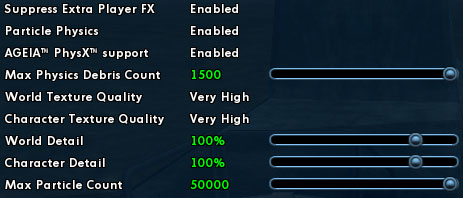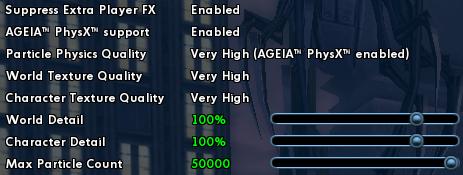PhysX Performance Update: City of Villains
by Ryan Smith on September 7, 2006 6:00 AM EST- Posted in
- GPUs
The last time we took a look at physics performance under City of Villains utilizing a PhysX card, the code was still in beta, and the results for the PhysX card were lackluster at best. What we found was that while utilizing a PhysX card did indeed enable CoV to generate a good deal of extra eye-candy, the cost came at an immense performance drop, especially to minimum framerates. At the time, AGEIA had promised that performance under CoV would improve between then and when the improvements were actually put into the Issue 7 patch. That patch has since shipped, and we are back to take a look at just what the PhysX card is capable of doing given more refined code.
Since the beta version of Issue 7 was in testing, Cryptic has also made several changes to CoV to better allow benchmarking, as previously FRAPS was the only way to do a repeatable test using higher physics settings. The CoV's benchmark mode now properly renders additional physics based on the game's settings, allowing for more controlled testing and more importantly testing against the live server where we can no longer copy characters. Also, the highest physics mode, previously only allowed with PhysX hardware installed, now can run completely under software, giving true apples-to-apples testing where all physics effects are the same.


This later point is particularly important, since AGEIA was able to confirm a few earlier theories we had on the game. In the highest quality mode (various physics modes have replaced the items slider), both the hardware and software physics engines end up doing the same physics routines with the same precise formulas. Meanwhile, in any of the lower quality modes the software engine is allowed to make approximations in return for the faster calculations, and at the lowest quality settings the software mode renders fewer overall effects. We'll look at how the various settings affect the performance and visual quality under CoV, so keep in mind that only the maximum quality mode is identical for both software and hardware physics.
Dual core performance is also something that has seen some changes since the Issue 7 beta, as the game is now capable of doing physics calculations on a separate core. As we'll see in a second, the game benefits tremendously from a second core, which may not be in AGEIA's best interests.
What does all of this mean for physics performance then under CoV? Let's take a look.
Since the beta version of Issue 7 was in testing, Cryptic has also made several changes to CoV to better allow benchmarking, as previously FRAPS was the only way to do a repeatable test using higher physics settings. The CoV's benchmark mode now properly renders additional physics based on the game's settings, allowing for more controlled testing and more importantly testing against the live server where we can no longer copy characters. Also, the highest physics mode, previously only allowed with PhysX hardware installed, now can run completely under software, giving true apples-to-apples testing where all physics effects are the same.


This later point is particularly important, since AGEIA was able to confirm a few earlier theories we had on the game. In the highest quality mode (various physics modes have replaced the items slider), both the hardware and software physics engines end up doing the same physics routines with the same precise formulas. Meanwhile, in any of the lower quality modes the software engine is allowed to make approximations in return for the faster calculations, and at the lowest quality settings the software mode renders fewer overall effects. We'll look at how the various settings affect the performance and visual quality under CoV, so keep in mind that only the maximum quality mode is identical for both software and hardware physics.
Dual core performance is also something that has seen some changes since the Issue 7 beta, as the game is now capable of doing physics calculations on a separate core. As we'll see in a second, the game benefits tremendously from a second core, which may not be in AGEIA's best interests.
What does all of this mean for physics performance then under CoV? Let's take a look.










31 Comments
View All Comments
Calin - Friday, September 8, 2006 - link
MMX and its successors were used to accelerate the hell out of many photoshop plug-ins (P4 in its worst days was faster running the optimised routines than Athlon64, and in many cases it was faster by a big amount).I think the video cards could be better at offloading this kind of calculation - maybe even more optimised routines will come soon (in many cases, graphic professionals use top-of-the-line cards, or even workstation-builds like NVidia Quadro and ATI FireGL)
Calin - Thursday, September 7, 2006 - link
Using Ageia PPU gives you about 35% or more extra performance in CoV, or 6fps. Using a dedicated sound card instead of a lowly integrated sound will give you 6fps in benchmarks of the Quake3 or so engines, for a 5% or so difference in frame rate. For just this purpose, PPU is better than a dedicated sound card (even if more expensive)DerekWilson - Thursday, September 7, 2006 - link
I can find a more expensive audio solution for you :-)But this is true -- percent difference is what we need to look at here.
Calin - Friday, September 8, 2006 - link
You could find a more expensive audio solution certainly - but I don't think you would be able to reduce the frame rate as compared to a $200 Creative 7.1 Channel Sound Blaster X-Fi Fatal1ty FPS (the price from Anandtech's own RealTime Pricing).Anyway, thanks for the article - nice written, and interesting. Thumbs up!
Marlin1975 - Thursday, September 7, 2006 - link
How abotu trying the PhysX on a board that has intergrated graphics? Would it help those stuck with pos intel onboard or even the better Ati/Nvidia onboard graphics? Onboard usually covers 2d ok and has some 3d, but maybe with a little help onboard can move up with little cost. (cost as in when the PhysX comes down to the real world in pricing)?Lonyo - Thursday, September 7, 2006 - link
Also, for less than the price of a PPU you can get a 7900GT.If you want to try and suggest a PPU is better than a 7900GT as an upgrade, well, hmm.
PrinceGaz - Thursday, September 7, 2006 - link
If a game is totally GPU limited (as is usually the case with onboard graphics), then a physics-card will make no difference whatsoever to performance.The PhysX card offloads work from the CPU, it does not offload any work from the GPU, so the PhysX card will not help people using onboard/slow graphics solutions.
Calin - Thursday, September 7, 2006 - link
Also, a physics card "creates" more debris, which is not only physics intensive to compute (paths and so on), but GPU intensive to render.Anyway, integrated graphics usually reduce the quality and resolution of possible gaming - using the money for the physics card for a new (or additional) graphic card would be the cheapest solution to fast, quality gaming. Not to mention you could get multimonitor capabilities in the price, maybe DVI and so on.
DerekWilson - Thursday, September 7, 2006 - link
This is quite true ... if you don't have a gpu that can handle what you are already throwing at it, a PhysX card won't do much. Sure it'll take off some CPU load, but chances are you aren't cpu limited. And if you tried turning up the debris settings you'd just be adding to the load on the GPU. Which could cause some performance decrease.We will keep this in mind for future tests and try to address the issue later. For now, it's safe to assume that you'll need at least a midrange quality graphics board to gain anything from PhysX.
yyrkoon - Thursday, September 7, 2006 - link
I think you'd have to be insane to think that running a game on a system with onboard video is going to do well in a Physics intensive game . . .